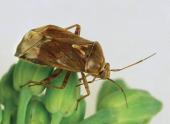
. Hemipterans, the true bugs, belong to an order of insects (Hemiptera) having a jointed proboscis or beak comprised of four sharp stylets for piercing-sucking their food. In many Hemipterans, the front wings are partly thickened, hard and leather-like, and partly membranous, giving the order the name Hemiptera, from the Greek words hemi, meaning half, and pteron, meaning wing. The systematics of the Hemiptera is in some disarray. Traditionally, the group was divided into two orders, the Heteroptera, or true bugs, and the Homoptera—aphids, leafhoppers, and related insects. Research has shown that the Homoptera are not a natural phylogenetic group. Morphological and molecular evidence, however, indicates that the Homoptera and Heteroptera are related at the order level.
There are several suborders in the order Hemiptera, the most common of which are: the Sternorrhyncha, comprising aphids, psyllids, whiteflies, and scale insects; the Auchenorrhyncha, including cicadas, leafhoppers, froghoppers, treehoppers, and planthoppers; and the Heteroptera, the true bugs, including plant bugs, seed bugs, and stink bugs. There are over 80,000 named species of Hemiptera worldwide, with Literature records of 1,012 species in Saskatchewan, and an estimated 200 to 300 more hemipteran species likely occurring in the province.
The Hemiptera are the most successful of the hemimetabolous insects. These are insects with incomplete metamorphosis, whose young resemble wingless adults. Instead of developing from egg to larva, to pupa, to adult, as do insects with complete metamorphosis, Hemiptera develop from eggs to nymphs to adults. The morphology of Hemiptera reflects the diverse habitats to which they have become adapted. They vary in size from minute external parasites of Birds to giant water bugs 50 mm long. The antennae of the Heteroptera comprise four or five segments, while those of other Hemiptera may be reduced and bristlelike, or long and filamentous. A main feature of the order is its piercing-sucking mouthparts, wherein the mandibles and maxillae form two pairs of piercing needlelike stylets that contain both feeding and salivary tubes, all contained in a flexible sheath derived from the labrum or upper lip.
All Sternorrhyncha and Auchenorrhyncha, and many Heteroptera, feed on plant vascular tissues or nutrients of developing seeds, and the order is one of the most economically destructive groups of insects. Piercing-sucking feeding results in localized injury, including discoloration, wilting, distortion, weakening or stunting of plant parts, or in some cases the formation of galls. Heavily infested plants may be killed. While some Hemiptera such as certain aphids have plant hosts restricted to one species or group of related species, others, such as the tarnished plant bug, Lygus lineolaris L., may have over 300 host plant species. Several families of Hemiptera, particularly aphids and leafhoppers, are vectors of plant pathogens such as Barley yellow dwarf virus and plum pox virus.
Not all Hemiptera are plant pests. Several heteropteran families include species that are predators of other arthropods. Families such as the assassin bugs (Reduviidae), ambush bugs (Phymatidae), damsel bugs (Nabidae), and minute pirate bugs (Anthocoridae), play an important role in the biological control of a variety of insects, many of which are economically damaging. There are several families of aquatic hemipteran predators, including water boatmen (Corixidae), water striders (Gerridae), water scorpions (Nepidae), and giant water bugs (Belostomatidae) that prey on aquatic insects such as mosquito larvae. And a few hemipteran species affect humans directly: bed bugs, in the family Cimicidae, are ectoparasites of birds and Mammals, including humans; Chagas’ disease is transmitted to humans by conenose bugs in the genus Triatoma.
Economically important Hemiptera that occur in Saskatchewan include aphids such as pea aphid, English grain aphid, and green peach aphid, and others such as spruce gall adelgid, pine needle scale, tomato psyllid, greenhouse whitefly, aster leafhopper, alfalfa plant bug, tarnished plant bug, and black grass bug. As exemplified by the range of families and habits of the order, Hemiptera are a fascinating and diverse group of insects.
Juliana Soroka
Print EntryHOME | BROWSE BY SUBJECT | ENTRY LIST (A-Z) | IMAGE INDEX | CONTRIBUTOR INDEX | ABOUT THE ENCYCLOPEDIA | SPONSORS TERMS OF USE | COPYRIGHT © 2006 CANADIAN PLAINS RESEARCH CENTER, UNIVERSITY OF REGINA | POWERED BY MERCURY CMS |
|||
| This web site was produced with financial assistance provided by Western Economic Diversification Canada and the Government of Saskatchewan. |
|||
 |
 |
 |
 |
| Ce site Web a été conçu grâce à l'aide financière de Diversification de l'économie de l'Ouest Canada et le gouvernement de la Saskatchewan. |
|||